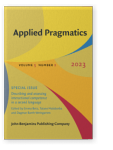Discussion published In:
Describing and assessing interactional competence in a second language: Special issue of the journal of Applied Pragmatics 5:2 (2023)Edited by Emma Betz, Taiane Malabarba and Dagmar Barth-Weingarten
[Applied Pragmatics 5:2] 2023
► pp. 280–288
